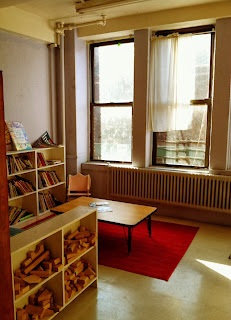 Beginning the day is a quick "Morning Standup" where everyone sets intentions, and updates their personal whiteboard to track their learning goals. These Kanban boards, shown here, help support many aspects of the school's curriculum:
Beginning the day is a quick "Morning Standup" where everyone sets intentions, and updates their personal whiteboard to track their learning goals. These Kanban boards, shown here, help support many aspects of the school's curriculum: - Identifying your own needs and priorities,
- Creating projects which accomplish those priorities,
- Organizing your time and activities around those projects,
- Focus and follow through on those projects toward a creative end,
- Sharing your creative output (in a digital portfolio),
- Reflecting on personal progress and impediments (in a personal blog),
- Co-creating a collaborative, supportive social environment,
- Responsibility for your action and inaction
- and Digital literacy
[from the school's website]
When I arrived, I saw democracy at work. Half of the students were excited about going iceskating on the following day, while the other half were opposed. Plans were made to split the adults so that all students could do what they most wanted.
The school is housed in an auxiliary church building in East Harlem, with six rooms loosely dedicated to different academic and artistic pursuits. The art/science experiment room had closets stuffed with test tubes and other chemistry gear, and a table covered with masks made of digital pixels: Minecraft is wildly popular with the students.
The sunny library was accessible both by the traditional door as well as a trapdoor/secret entrance, created when students decided to strip the molding off the bottom panel and add a few hinges. This freedom to transform physical spaces continues to delight and challenge me as I explore free schools.

After my tour, I sat in on a Philosophy Club meeting. This club was one of a handful of opt-in activities and classes offered that day. Children were presented with a series of moral quandaries, and tried to come to a consensus on which solutions were morally permissible. I had intended to just observe, but ended up participating in the debates, as my opinion was asked again and again.
The children took a break from a heated debate to enjoy LaCroix-- a flavored sparkling water. The water was supplied by a former parent as tuition compensation. I so appreciate the flexibility and willingness to work with families on tuition.
After the club, I went searching for students to observe. I found five sitting around the couch in the library, talking and laughing and building worlds together in Minecraft. Although each child had their own laptop, most of the work they were doing was collaborative. At one point, one child asked for everyone to take a break and watch his screen while he test drove through the enormous, multiworld roller coaster that he had constructed. There was lots of positive feedback from the other students here, in whoops and laughter.
The next five minutes blew my mind. One small boy said he wanted to do some math, and pulled up his account on Kahn Academy. As he logged in, he told me that he has 50% mastered all of the lessons intended for high schoolers. The adaptive program gave a series of problems on simplifying square roots. Opening a second browser tab, he began a lightening-fast fact check utilizing the autocomplete mechanism and some sophisticated mental math. Watching and wondering at his speed and confidence, I asked how he had learned to complete these problems.
"Youtube! I can show you the video on simplifying square roots. Do you want to watch it on slow mo? I usually watch it on double time."
To demonstrate, he pulled up the video, and clicked on the settings to change the speed. As the narrator started spewing facts, my small teacher paused the video to politely ask the group playing Minecraft to turn down the volume.
My mind was whirling-- at how quickly this child was able to process complex math concepts, and at his glee and drive to do so. Turning to him, I asked: "So how old are you anyway?" "10," he replied.
After a half hour of intently focused math work, he returned to the Minecraft group. I imagine that in that half hour, he likely learned more math than many children learn in a week or better.
Thoughts:
The school has simple and effective systems to incorporate outside guests into the day: Parents and other community members can volunteer an offering such as a class, an experience, materials, etc. These offerings are sticky-noted to a board, and each Monday during planning time for the week, the community as a whole decides when and how these offerings are to be incorporated into the school day.
I really appreciated the Kanban boards: how the community can make their learning process visible. Daily and weekly cycles of intention-setting and reflection help hold students and adults accountable for their learning. I imagine that graduates internalize these structures, and continue to use them through adulthood.
Do you have other methods to set goals, track progress, and reflect on learning? I think this is what being a life-long learner is all about.



No comments:
Post a Comment